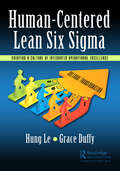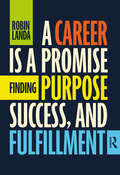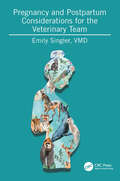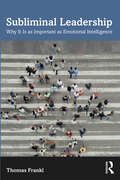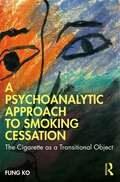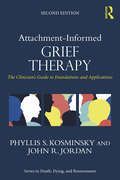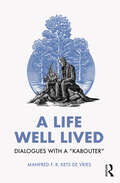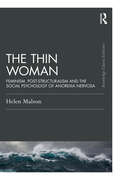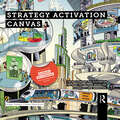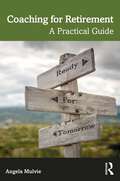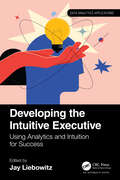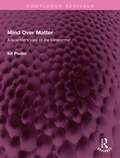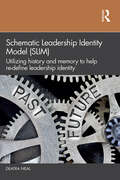- Table View
- List View
Human-Centered Lean Six Sigma: Creating a Culture of Integrated Operational Excellence
by Hung Le Grace DuffyThis book focuses on the human side of organizational culture. The authors approach organizational culture from the perspective of alignment to mission, vision, and values. Using a Lean Six Sigma structure, the sequence of chapters begins with the organization and its structure, then drills through strategic, operational, and tactical levels of process and behavior which establish and grow the overall culture of the organization over time. The book begins with foundational principles of organization, through the necessity of aligning processes and systems to mission and vision, assessment, gap analysis for improvement, prioritization, and chapters on qualitative and quantitative approaches for reducing variation and improving systems and behavior. Through this book, readers will: Learn the foundation and core concepts of the organization Discover the "right" focus of shifting the culture of the organization Recognize the building blocks of organizational culture and how to integrate them into a successful, customer-focused system of interconnected processes Focus on people as drivers of technology, rather than the reverse Explore techniques to address the challenges and concerns of today’s training and deployment for organizational performance excellence Use the chapters as short discussions or training workshops for either internal education or public/private technical education.
A Career Is a Promise: Finding Purpose, Success, and Fulfillment
by Robin LandaNo matter your field of interest, A Career is a Promise offers a proven framework for finding purpose, fulfillment, and success. Robin Landa, one of the world's leading experts on creativity and idea generation, reveals practical strategies that will help you identify a career worthy of your intelligence, aptitudes, and time. Much more than a how-to guide, the roadmaps, prompts, inner directed questions, and self-assessment tools will help you discover what most excites you professionally, how to set worthwhile career goals, find purpose in your career, achieve success, lead with compassion, find fulfillment, secure mentors and sponsors, and enhance your creative thinking to best compete in a global marketplace. Most of us don’t spend adequate time thinking about what ignites our souls and makes careers roar–well enough to forge a fruitful and satisfying career path. When you spend more than one third of your life working, your career should hold promise. A career is a promise you make to yourself.
A Career Is a Promise: Finding Purpose, Success, and Fulfillment
by Robin LandaNo matter your field of interest, A Career is a Promise offers a proven framework for finding purpose, fulfillment, and success. Robin Landa, one of the world's leading experts on creativity and idea generation, reveals practical strategies that will help you identify a career worthy of your intelligence, aptitudes, and time. Much more than a how-to guide, the roadmaps, prompts, inner directed questions, and self-assessment tools will help you discover what most excites you professionally, how to set worthwhile career goals, find purpose in your career, achieve success, lead with compassion, find fulfillment, secure mentors and sponsors, and enhance your creative thinking to best compete in a global marketplace. Most of us don’t spend adequate time thinking about what ignites our souls and makes careers roar–well enough to forge a fruitful and satisfying career path. When you spend more than one third of your life working, your career should hold promise. A career is a promise you make to yourself.
Pregnancy and Postpartum Considerations for the Veterinary Team
by Emily SinglerPrecautions often apply to pregnancy in any workplace, but being a vet in practice presents additional specific risks. There are concerns and uncertainty about potential hazards, from radiation and inhalant anesthesia exposure, to zoonoses, and the additional mental stress in a profession that already carries high suicide risk. This book reviews considerations for professionals in clinical veterinary medicine (large and small animal) while pregnant and after giving birth. Veterinarian and veterinary writer, consultant, and mentor Dr Emily Singler speaks directly to veterinary team members (veterinarians, technicians, CSRs, assistants, students) who are pregnant or plan to become pregnant. She delivers scientific information on the specific risks to the mother and baby that may be encountered during pregnancy while working in veterinary medicine, with some of her own and others’ experiences to add perspective and humor. The book also covers topics related to mental health challenges, announcing a pregnancy and planning for parental leave, navigating the fourth trimester, and returning to work. We hope that having read this book, veterinary professionals – whether pregnant or working with pregnant colleagues – will feel better supported and empowered to make informed decisions.
Pregnancy and Postpartum Considerations for the Veterinary Team
by Emily SinglerPrecautions often apply to pregnancy in any workplace, but being a vet in practice presents additional specific risks. There are concerns and uncertainty about potential hazards, from radiation and inhalant anesthesia exposure, to zoonoses, and the additional mental stress in a profession that already carries high suicide risk. This book reviews considerations for professionals in clinical veterinary medicine (large and small animal) while pregnant and after giving birth. Veterinarian and veterinary writer, consultant, and mentor Dr Emily Singler speaks directly to veterinary team members (veterinarians, technicians, CSRs, assistants, students) who are pregnant or plan to become pregnant. She delivers scientific information on the specific risks to the mother and baby that may be encountered during pregnancy while working in veterinary medicine, with some of her own and others’ experiences to add perspective and humor. The book also covers topics related to mental health challenges, announcing a pregnancy and planning for parental leave, navigating the fourth trimester, and returning to work. We hope that having read this book, veterinary professionals – whether pregnant or working with pregnant colleagues – will feel better supported and empowered to make informed decisions.
Subliminal Leadership: Why It Is as Important as Emotional Intelligence
by Thomas FranklUnderstanding the power of subliminal influence makes or breaks leaders. What is it that subliminally motivates people to give their best, not just what’s in their job description? How do you build an outstanding team? (Spoiler: it’s not just by putting the best people in a team.) The answer lies in the power of subliminal influence. This book explains in a clear and accessible way this important, yet little known and understood, area of psychology and leadership. As Emotional Intelligence helped managers and leaders to understand the importance of empathy in the workplace, Subliminal Leadership takes us to the next level by explaining how influence through non-verbal communication mostly happens below the threshold of our conscious awareness: subliminal forms of body language and communication which influence other people's attitudes, thinking and behavior – and which may boost, or undermine a leader's authority, the performance of teams or the quality of key customer relationships. Readers will learn how we unconsciously communicate and how we positively or negatively influence other people in the process. Understanding subliminal influence will help people in, or aspiring towards, leadership positions to build trust, understand others’ emotions, make better decisions, and strengthen professional relationships. Based on recent scientific research in disciplines as diverse as psychology, evolutionary biology, anthropology, medicine, neuroscience, and management studies, the book offers a breakthrough, multidisciplinary approach to influence and leadership. This book is for everyone interested in the psychological, biological, and medical dimensions of leadership.
Subliminal Leadership: Why It Is as Important as Emotional Intelligence
by Thomas FranklUnderstanding the power of subliminal influence makes or breaks leaders. What is it that subliminally motivates people to give their best, not just what’s in their job description? How do you build an outstanding team? (Spoiler: it’s not just by putting the best people in a team.) The answer lies in the power of subliminal influence. This book explains in a clear and accessible way this important, yet little known and understood, area of psychology and leadership. As Emotional Intelligence helped managers and leaders to understand the importance of empathy in the workplace, Subliminal Leadership takes us to the next level by explaining how influence through non-verbal communication mostly happens below the threshold of our conscious awareness: subliminal forms of body language and communication which influence other people's attitudes, thinking and behavior – and which may boost, or undermine a leader's authority, the performance of teams or the quality of key customer relationships. Readers will learn how we unconsciously communicate and how we positively or negatively influence other people in the process. Understanding subliminal influence will help people in, or aspiring towards, leadership positions to build trust, understand others’ emotions, make better decisions, and strengthen professional relationships. Based on recent scientific research in disciplines as diverse as psychology, evolutionary biology, anthropology, medicine, neuroscience, and management studies, the book offers a breakthrough, multidisciplinary approach to influence and leadership. This book is for everyone interested in the psychological, biological, and medical dimensions of leadership.
A Psychoanalytic Approach to Smoking Cessation: The Cigarette as a Transitional Object
by Fung KoA Psychoanalytic Approach to Smoking Cessation: The Cigarette as a Transitional Object provides an accessible understanding to the unconscious motive behind smoking addiction using Winnicott’s concept of the transitional object. The book is divided thematically into six parts. Ko begins by outlining the conscious motives for smoking from a psychological perspective and looks at commercial research conducted by the tobacco industry, before using psychoanalytically informed cross-disciplinary literature to assess the unconscious motives for smoking. She expertly introduces Winnicott’s view on smoking addiction, using his concept of the transitional object, and highlights the power of the Free Association Narrative Interview method in accessing the unconscious and embedded emotional experiences. Using clinical examples, she illustrates the benefits of this method as a tool to elicit free associations from research respondents. She details the parallels between the individual respondents’ smoking experience, as well as their relationship with cigarettes and the seven qualities of transitional objects outlined by Winnicott in his 1953 landmark paper. Ko concludes by emphasising the significance and implications of this thesis to smokers and public health policy, as well as the smoking cessation approach and proposed directions for future research. This book is an essential resource for psychoanalysts and psychotherapists working in smoking cessation organisations, as well as those working in addiction services.
A Psychoanalytic Approach to Smoking Cessation: The Cigarette as a Transitional Object
by Fung KoA Psychoanalytic Approach to Smoking Cessation: The Cigarette as a Transitional Object provides an accessible understanding to the unconscious motive behind smoking addiction using Winnicott’s concept of the transitional object. The book is divided thematically into six parts. Ko begins by outlining the conscious motives for smoking from a psychological perspective and looks at commercial research conducted by the tobacco industry, before using psychoanalytically informed cross-disciplinary literature to assess the unconscious motives for smoking. She expertly introduces Winnicott’s view on smoking addiction, using his concept of the transitional object, and highlights the power of the Free Association Narrative Interview method in accessing the unconscious and embedded emotional experiences. Using clinical examples, she illustrates the benefits of this method as a tool to elicit free associations from research respondents. She details the parallels between the individual respondents’ smoking experience, as well as their relationship with cigarettes and the seven qualities of transitional objects outlined by Winnicott in his 1953 landmark paper. Ko concludes by emphasising the significance and implications of this thesis to smokers and public health policy, as well as the smoking cessation approach and proposed directions for future research. This book is an essential resource for psychoanalysts and psychotherapists working in smoking cessation organisations, as well as those working in addiction services.
Attachment-Informed Grief Therapy: The Clinician’s Guide to Foundations and Applications (Series in Death, Dying, and Bereavement)
by Phyllis S. Kosminsky John R. JordanAttachment-Informed Grief Therapy bridges the fields of attachment studies, thanatology, and interpersonal neuroscience, uniting theory, research, and practice to enrich our understanding of how we can help the bereaved. The new edition includes updated research and discussion of emotion regulation, relational trauma, epistemic trust, and much more. In these pages, clinicians and students will gain a new understanding of the etiology of problematic grief and its treatment, and will become better equipped to formulate accurate and specific case conceptualization and treatment plans. The authors also illustrate the ways in which the therapeutic relationship is crucially important – though largely unrecognized – element in grief therapy and offer guidelines for an attachment-informed view of the therapeutic relationship that can serve as the foundation of all grief therapy. Written by two highly experienced grief counselors, this volume is filled with instructive case vignettes and useful techniques that offer a universal and practical frame of reference for understanding grief therapy for clinicians of every theoretical persuasion.
A Life Well Lived: Dialogues with a “Kabouter"
by Manfred F. Kets de VriesManfred Kets de Vries wears many “hats”—psychoanalyst, executive coach, consultant, management educator, researcher, writer—but he has noticed that whichever hat he is wearing, every question he is asked boils down to one thing: “How can I live a well-lived life?” Over many years of practice in all these disciplines, Professor Kets de Vries has realized the unsurpassed value of stories in tackling human dilemmas and providing answers to this question. The book is, therefore, one of the most important books he has written for coaches, students, leaders, managers, educators—or anyone seeking a more reflective text to guide them through the multitude of questions that we face in work and in life. He draws on a long literary tradition of the unexpected encounter with a wise “other,” fantastic or magical—think The Little Prince, Alice's Adventures in Wonderland, The Once and Future King, the Harry Potter novels—to animate an exploration of the deepest questions and concerns of human beings. He constructs an extended Socratic dialogue between his two “selves”; the first a naïve traveler, lost in the Siberian wilderness, and the second a reflective avatar who comes to his aid. The avatar takes the form of a “kabouter,” a familiar figure in Dutch folklore whose counterpart can be found in different cultures around the world and throughout centuries of storytelling. Through stories, riddles, and puzzles, the kabouter challenges the traveler to question and reflect upon his life and values, guiding him—and readers—toward the insights that will help them achieve a life well lived.
Attachment-Informed Grief Therapy: The Clinician’s Guide to Foundations and Applications (Series in Death, Dying, and Bereavement)
by Phyllis S. Kosminsky John R. JordanAttachment-Informed Grief Therapy bridges the fields of attachment studies, thanatology, and interpersonal neuroscience, uniting theory, research, and practice to enrich our understanding of how we can help the bereaved. The new edition includes updated research and discussion of emotion regulation, relational trauma, epistemic trust, and much more. In these pages, clinicians and students will gain a new understanding of the etiology of problematic grief and its treatment, and will become better equipped to formulate accurate and specific case conceptualization and treatment plans. The authors also illustrate the ways in which the therapeutic relationship is crucially important – though largely unrecognized – element in grief therapy and offer guidelines for an attachment-informed view of the therapeutic relationship that can serve as the foundation of all grief therapy. Written by two highly experienced grief counselors, this volume is filled with instructive case vignettes and useful techniques that offer a universal and practical frame of reference for understanding grief therapy for clinicians of every theoretical persuasion.
A Life Well Lived: Dialogues with a “Kabouter"
by Manfred F. Kets de VriesManfred Kets de Vries wears many “hats”—psychoanalyst, executive coach, consultant, management educator, researcher, writer—but he has noticed that whichever hat he is wearing, every question he is asked boils down to one thing: “How can I live a well-lived life?” Over many years of practice in all these disciplines, Professor Kets de Vries has realized the unsurpassed value of stories in tackling human dilemmas and providing answers to this question. The book is, therefore, one of the most important books he has written for coaches, students, leaders, managers, educators—or anyone seeking a more reflective text to guide them through the multitude of questions that we face in work and in life. He draws on a long literary tradition of the unexpected encounter with a wise “other,” fantastic or magical—think The Little Prince, Alice's Adventures in Wonderland, The Once and Future King, the Harry Potter novels—to animate an exploration of the deepest questions and concerns of human beings. He constructs an extended Socratic dialogue between his two “selves”; the first a naïve traveler, lost in the Siberian wilderness, and the second a reflective avatar who comes to his aid. The avatar takes the form of a “kabouter,” a familiar figure in Dutch folklore whose counterpart can be found in different cultures around the world and throughout centuries of storytelling. Through stories, riddles, and puzzles, the kabouter challenges the traveler to question and reflect upon his life and values, guiding him—and readers—toward the insights that will help them achieve a life well lived.
The Thin Woman: Feminism, Post-structuralism and the Social Psychology of Anorexia Nervosa (Psychology Press & Routledge Classic Editions)
by Helen MalsonThe First Edition of The Thin Woman, first published in 1998, provides an in-depth discussion of anorexia nervosa from a critical feminist social psychological standpoint. In the original text, the author argues that the notion of 'anorexia' as a medical condition limits our understanding of anorexia and the extent to which we can explore it as a socially and discursively produced problem. The book now has a new introduction that discusses some of the major cultural and academic developments that have occurred since its first publication. In considering our changing cultural landscapes, the introduction goes on to discuss the so-called ‘obesity crisis’; the emergence of post-feminism; the massive global expansion of digital and social media and, most recently, the Covid-19 pandemic. Turning to academic developments, it focuses on the increasing recognition of intersectional feminism and reflects on how intersectional perspectives are now beginning to shape critical feminist research and theory in this field. The new introduction also highlights the significant growth in the last 25 years of critical feminist research on eating disorders, which has brought with it a greater awareness of intersectional theory and a more inclusive agenda; an expansion of research foci; a diversification of methodologies and the emergence of more egalitarian models of research in which those with lived experience of eating disorders are becoming valued research team members who help to shape research aims, designs and processes. Based on original research using historical and contemporary literature on anorexia nervosa and a series of interviews with women who identified as ‘anorexic’, this book offers critical insights into this problem. It is an invaluable read for anyone interested in eating disorders and gender, developments in feminist post-structuralist theory and discourse analytic research in psychology.
The Thin Woman: Feminism, Post-structuralism and the Social Psychology of Anorexia Nervosa (Psychology Press & Routledge Classic Editions)
by Helen MalsonThe First Edition of The Thin Woman, first published in 1998, provides an in-depth discussion of anorexia nervosa from a critical feminist social psychological standpoint. In the original text, the author argues that the notion of 'anorexia' as a medical condition limits our understanding of anorexia and the extent to which we can explore it as a socially and discursively produced problem. The book now has a new introduction that discusses some of the major cultural and academic developments that have occurred since its first publication. In considering our changing cultural landscapes, the introduction goes on to discuss the so-called ‘obesity crisis’; the emergence of post-feminism; the massive global expansion of digital and social media and, most recently, the Covid-19 pandemic. Turning to academic developments, it focuses on the increasing recognition of intersectional feminism and reflects on how intersectional perspectives are now beginning to shape critical feminist research and theory in this field. The new introduction also highlights the significant growth in the last 25 years of critical feminist research on eating disorders, which has brought with it a greater awareness of intersectional theory and a more inclusive agenda; an expansion of research foci; a diversification of methodologies and the emergence of more egalitarian models of research in which those with lived experience of eating disorders are becoming valued research team members who help to shape research aims, designs and processes. Based on original research using historical and contemporary literature on anorexia nervosa and a series of interviews with women who identified as ‘anorexic’, this book offers critical insights into this problem. It is an invaluable read for anyone interested in eating disorders and gender, developments in feminist post-structuralist theory and discourse analytic research in psychology.
Strategy Activation Canvas
by Ansgar Thiessen Robert WreschniokThe Strategy Activation Canvas is the new standard for accelerating strategies – beginning where classical strategies end: with its activation. While many management and business canvases focus on developing a strategy, the Strategy Activation Canvas helps leaders and decision-makers to bring strategies to life. This book demonstrates for the first time how entire organizations can be “activated”: how people can not only perceive and implement a new strategy, but how entire organizations can be heavily involved in its making, how strategies are made visible and experienced, and how people can play an active and sustaining role throughout bringing a strategy to life. With their decades of experience in large scale organizations, Thiessen and Wreschniok pair their knowledge with case studies from Allianz, Baloise, E.ON, Hamburg Commercial Bank, Microsoft, NORD/LB, Swisscom or Swiss Re, shared by leaders who have remarkably accelerated the success and value of their strategies on the back of strategy activation. This book is an essential resource for managers who have responsibility for strategic initiatives and transformation programs of any kind.
Strategy Activation Canvas
by Ansgar Thiessen Robert WreschniokThe Strategy Activation Canvas is the new standard for accelerating strategies – beginning where classical strategies end: with its activation. While many management and business canvases focus on developing a strategy, the Strategy Activation Canvas helps leaders and decision-makers to bring strategies to life. This book demonstrates for the first time how entire organizations can be “activated”: how people can not only perceive and implement a new strategy, but how entire organizations can be heavily involved in its making, how strategies are made visible and experienced, and how people can play an active and sustaining role throughout bringing a strategy to life. With their decades of experience in large scale organizations, Thiessen and Wreschniok pair their knowledge with case studies from Allianz, Baloise, E.ON, Hamburg Commercial Bank, Microsoft, NORD/LB, Swisscom or Swiss Re, shared by leaders who have remarkably accelerated the success and value of their strategies on the back of strategy activation. This book is an essential resource for managers who have responsibility for strategic initiatives and transformation programs of any kind.
Coaching for Retirement: A Practical Guide
by Angela MulvieRetirement is a time of both challenge and opportunity, which can be a daunting prospect. This highly practical book, written for coaches and HR professionals who are supporting others through the process, shows what can be done to help people towards a successful change in their lives and circumstances as they move towards post-employment. Coaching for Retirement explores how to coach people towards sound planning for and management of retirement, from both an employer and employee perspective. The book considers how coaching has evolved to include retirement coaching as a growing specialism, and how retirement itself is changing because of a range of social, economic and political factors, both in the UK and globally. As a recent retiree herself, as well as an experienced coach, Angela Mulvie provides useful and interesting insights into the factors impacting how people plan and prepare for this next stage, answering key questions such as: How can the pre-retirement needs of staff be determined? How might retirement coaching support the decision-making processes involved? What options might individuals consider, e.g. part-time work, volunteering, pursuit of a second/portfolio career, new learning opportunities, etc.? What financial implications do people need to explore and how can these be prioritized? How can emotional aspects of retirement – health, wellbeing and relationships – be supported? What tools are available to support people in planning their retirement? As organizations are increasingly recognizing the importance of providing support to employees at all stages of their careers, this is an essential resource for coaches, HR professionals and all professionals involved in retirement planning.
Coaching for Retirement: A Practical Guide
by Angela MulvieRetirement is a time of both challenge and opportunity, which can be a daunting prospect. This highly practical book, written for coaches and HR professionals who are supporting others through the process, shows what can be done to help people towards a successful change in their lives and circumstances as they move towards post-employment. Coaching for Retirement explores how to coach people towards sound planning for and management of retirement, from both an employer and employee perspective. The book considers how coaching has evolved to include retirement coaching as a growing specialism, and how retirement itself is changing because of a range of social, economic and political factors, both in the UK and globally. As a recent retiree herself, as well as an experienced coach, Angela Mulvie provides useful and interesting insights into the factors impacting how people plan and prepare for this next stage, answering key questions such as: How can the pre-retirement needs of staff be determined? How might retirement coaching support the decision-making processes involved? What options might individuals consider, e.g. part-time work, volunteering, pursuit of a second/portfolio career, new learning opportunities, etc.? What financial implications do people need to explore and how can these be prioritized? How can emotional aspects of retirement – health, wellbeing and relationships – be supported? What tools are available to support people in planning their retirement? As organizations are increasingly recognizing the importance of providing support to employees at all stages of their careers, this is an essential resource for coaches, HR professionals and all professionals involved in retirement planning.
Developing the Intuitive Executive: Using Analytics and Intuition for Success (Data Analytics Applications)
by Jay LiebowitzThe leading traits of executives often include creativity and innovation. Research shows that intuition can significantly enhance to these traits. Developing intuitive executives and honing intuition, coupled with the ability to apply data and evidence to inform decision making, is the focus of Developing the Intuitive Executive: Using Analytics and Intuition for Success. Some researchers call the complement of applying data analytics to intuition as quantitative intuition, rational intuition, or informed intuition. Certainly, in today's data-driven environment, analytics plays a key role in executive decision-making. However, an executive’s many years of experiential learning are not formally considered as part of the decision-making process. Learning from both failures and successes can help fine-tune intuitive awareness—what this book calls intuition-based decision-making. Research also shows that many executives do not trust the internal data quality in their organizations, and so they rely on their intuition rather than strictly on data. This book presents the work of leading researchers worldwide on intuition in the management and executive domain. Their chapters cover key issues, trends, concepts, techniques, and opportunities for applying intuition as part of the executive decision-making process. Highlights include: Using intuition to manage new opportunities Intuition in medicine Rules based on intuition Balancing logic and intuition in decision-making Smart heuristics to manage complexity Intuition and competitiveness Intuitive investment decision-making across cultures Showing how intuition in executive decision making should play an important role, this book enables managers to complement their knowledge gained from experience with analytics to improve decision-making and business success.
Developing the Intuitive Executive: Using Analytics and Intuition for Success (Data Analytics Applications)
by Jay LiebowitzThe leading traits of executives often include creativity and innovation. Research shows that intuition can significantly enhance to these traits. Developing intuitive executives and honing intuition, coupled with the ability to apply data and evidence to inform decision making, is the focus of Developing the Intuitive Executive: Using Analytics and Intuition for Success. Some researchers call the complement of applying data analytics to intuition as quantitative intuition, rational intuition, or informed intuition. Certainly, in today's data-driven environment, analytics plays a key role in executive decision-making. However, an executive’s many years of experiential learning are not formally considered as part of the decision-making process. Learning from both failures and successes can help fine-tune intuitive awareness—what this book calls intuition-based decision-making. Research also shows that many executives do not trust the internal data quality in their organizations, and so they rely on their intuition rather than strictly on data. This book presents the work of leading researchers worldwide on intuition in the management and executive domain. Their chapters cover key issues, trends, concepts, techniques, and opportunities for applying intuition as part of the executive decision-making process. Highlights include: Using intuition to manage new opportunities Intuition in medicine Rules based on intuition Balancing logic and intuition in decision-making Smart heuristics to manage complexity Intuition and competitiveness Intuitive investment decision-making across cultures Showing how intuition in executive decision making should play an important role, this book enables managers to complement their knowledge gained from experience with analytics to improve decision-making and business success.
Mind Over Matter: A scientist's view of the paranormal (Routledge Revivals)
by Kit PedlerFirst published in 1981, Mind Over Matter stems from Kit Pedler’s TV series of the same name and is an engrossing, open-minded survey of all aspects of the paranormal. It controversially suggests that metal-bending, telepathy, precognition and out-of-body experiences may not after all be the domain of frauds alone. Although criticised over the years, the book still fills the readers with creativity and wonder, and maybe even provides some explanation for inexplicable events in life.
Mind Over Matter: A scientist's view of the paranormal (Routledge Revivals)
by Kit PedlerFirst published in 1981, Mind Over Matter stems from Kit Pedler’s TV series of the same name and is an engrossing, open-minded survey of all aspects of the paranormal. It controversially suggests that metal-bending, telepathy, precognition and out-of-body experiences may not after all be the domain of frauds alone. Although criticised over the years, the book still fills the readers with creativity and wonder, and maybe even provides some explanation for inexplicable events in life.
Schematic Leadership Identity Model (SLIM): Utilizing History and Memory to Help Re-define Leadership Identity
by Deatra L NealA workbook for leaders who desire to be more effective and deliberate in their leadership identity and for young leaders coming into their own, this book introduces a unique two-step process to understand and define your leadership identity. While some leadership frameworks operate under static concepts of what makes a good leader, the Schematic Leadership Identity Model (SLIM) offers new and seasoned leaders an opportunity to explore the anchoring of who they are and the ebbs and flows of their attitudes and behaviors through life’s changes and experiences. The SLIM framework has two main footings of its seven phases: revolution, which is the recognition of one’s identity journey, and the theoretical constructs that help frame the process and evolution, a series of assignments and journal entries that helps each leader acknowledge their current leadership identity, unravel habits and behaviors that may not align with their idealized self, and redefine their leadership identity based on their findings and whom they aspire to be. The evolutionary design is a system necessary to be revisited as a leader goes deeper into their memories and experiences. This framework helps unearth unconscious and implicit biases that can hinder a leader’s social and cultural capital. No matter the industry or discipline, SLIM offers leaders a self-guided process of discovery that can profoundly examine the root causes of behaviors and attitudes to create meaningful change within themselves that can produce significant positive changes in their teams and organizations.
Schematic Leadership Identity Model (SLIM): Utilizing History and Memory to Help Re-define Leadership Identity
by Deatra L NealA workbook for leaders who desire to be more effective and deliberate in their leadership identity and for young leaders coming into their own, this book introduces a unique two-step process to understand and define your leadership identity. While some leadership frameworks operate under static concepts of what makes a good leader, the Schematic Leadership Identity Model (SLIM) offers new and seasoned leaders an opportunity to explore the anchoring of who they are and the ebbs and flows of their attitudes and behaviors through life’s changes and experiences. The SLIM framework has two main footings of its seven phases: revolution, which is the recognition of one’s identity journey, and the theoretical constructs that help frame the process and evolution, a series of assignments and journal entries that helps each leader acknowledge their current leadership identity, unravel habits and behaviors that may not align with their idealized self, and redefine their leadership identity based on their findings and whom they aspire to be. The evolutionary design is a system necessary to be revisited as a leader goes deeper into their memories and experiences. This framework helps unearth unconscious and implicit biases that can hinder a leader’s social and cultural capital. No matter the industry or discipline, SLIM offers leaders a self-guided process of discovery that can profoundly examine the root causes of behaviors and attitudes to create meaningful change within themselves that can produce significant positive changes in their teams and organizations.
